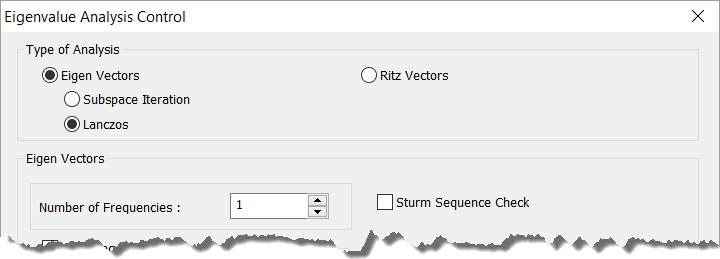[ANALYSIS] How to define more modes of vibration? Only a single mode is shown on performing response spectrum analysis.
Under the Eigenvalue Analysis Control, the number of frequencies
has to be set accordingly.
From Main Menu select Analysis > Analysis Control > Eigenvalue
In general, the number of modes to be considered for free vibration analysis are determined by modal mass participation.
Most of the literature concedes that at least 90% of modal mass participation should be considered for an acceptable analysis.

The default number of frequencies for eigenvalue analysis is set to 1. Usually, it is more than 1 which could be altered with suitable
number of frequencies in the dialogue box highlighted above .
Lanczos method
Adopted for relatively simpler structure to study the lower modes. The Lanczos method may miss some Eigen pairs in the required ones.
However for practical eigenvalue analysis method, the exact dynamic response has to be obtained which requires the missed eigenvalues to be included.
‘Sturm Sequence Check’ should be selected to check the same.
Subspace Iteration method
When performing Eigenvalue analysis for a finite element system of a large scale (large matrix system), Subspace Iteration method is effectively used.
Ritz Vector
For a model with large degrees of freedom (Say, for model with pile spring supports), Ritz vector method may be more appropriate.
Unlike the natural eigenvalue modes, Ritz vectors are load dependent and produce more reliable results in
dynamic analyses with relatively fewer modes. The Ritz Vectors are generated reflecting the spatial distribution
or the characteristics of the dynamic loading.
has to be set accordingly.
From Main Menu select Analysis > Analysis Control > Eigenvalue
In general, the number of modes to be considered for free vibration analysis are determined by modal mass participation.
Most of the literature concedes that at least 90% of modal mass participation should be considered for an acceptable analysis.
The default number of frequencies for eigenvalue analysis is set to 1. Usually, it is more than 1 which could be altered with suitable
number of frequencies in the dialogue box highlighted above .
Lanczos method
Adopted for relatively simpler structure to study the lower modes. The Lanczos method may miss some Eigen pairs in the required ones.
However for practical eigenvalue analysis method, the exact dynamic response has to be obtained which requires the missed eigenvalues to be included.
‘Sturm Sequence Check’ should be selected to check the same.
Subspace Iteration method
When performing Eigenvalue analysis for a finite element system of a large scale (large matrix system), Subspace Iteration method is effectively used.
Ritz Vector
For a model with large degrees of freedom (Say, for model with pile spring supports), Ritz vector method may be more appropriate.
Unlike the natural eigenvalue modes, Ritz vectors are load dependent and produce more reliable results in
dynamic analyses with relatively fewer modes. The Ritz Vectors are generated reflecting the spatial distribution
or the characteristics of the dynamic loading.
| Files | ||
|---|---|---|

|
||
|
|

